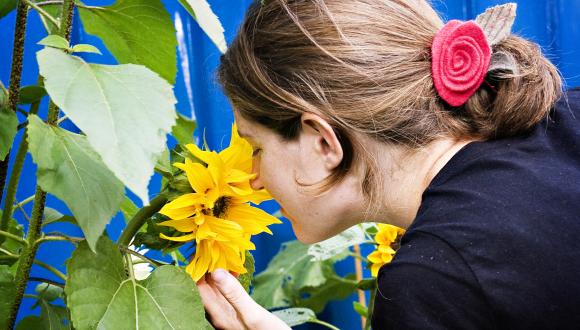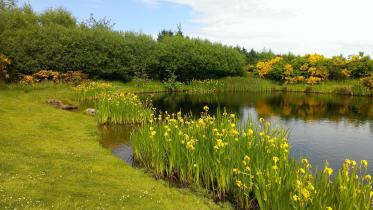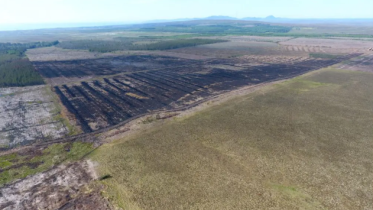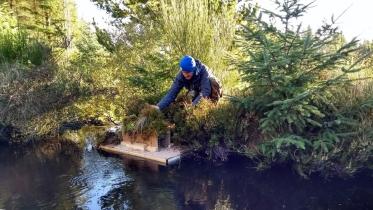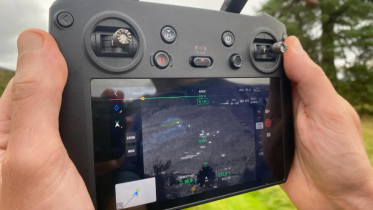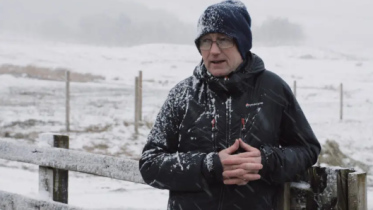Planning Performance Framework - Annual report 2021/22
Introduction
This is a report to the Scottish Government on our performance within the Planning System during the period 1 April 2021 to 31 March 2022. It reports against a series of performance markers covering different elements of our engagement in the Planning System, and identifies priorities for improvement during the next reporting period from1 April 2022 to 31 March 2023. It follows a template agreed with the other Key Agencies and the Scottish Government.
Description of our service
Our planning service includes advice and associated guidance and capacity-building. It supports implementation of the Third National Planning Framework, and accords with Scottish Planning Policy and the Scottish Regulators’ Strategic Code of Practice. It helps deliver the Scottish Government’s commitment to tackling the twin challenges of climate change and biodiversity loss, and the transition to a net zero carbon economy that is fair for all. The service has a vital part to play in Scotland’s ’green recovery’ from the Covid-19 pandemic and ensuring a resilient nature-rich future.
Our Planning for Development service statement Planning for Great Places outlines our approach and the support that stakeholders can expect from us. It emphasises the connection between people, development and nature, and the importance of achieving the right development in the right place to make Scotland the best place to live, work, visit and do business. It focuses our efforts on upstream engagement in the Planning System; working together with business interests; and providing clear, early advice that is alert to other interests and provides certainty for investment. In summary, we:
- influence national strategic development policies and plans and associated Strategic Environmental Assessment (SEA);
- input to regional and local spatial plans as an active partner in Development and Marine Planning, master plans and action programmes;
- publish guidance and standing advice to help developers assess and minimise impacts on nature;
- provide pre-application advice to developers, and advice to decision-makers focused on matters of potential national interest;
- inform post consent monitoring at a strategic and project level to advance understanding of the impact of development on nature;
- build greater capacity amongst developers and planning authorities to identify nature-based solutions and make sustainable use of our natural assets.
Together with other public bodies and agencies we have embedded the Place Principle in the way we work, to help overcome organisational and sectoral boundaries, and encourage better collaboration and community involvement. The application of our balancing duties helps to make sure we are alert to wider social and economic interests when discharging our responsibilities for nature, and that we are helping to shape Scotland as an inclusive, fair, prosperous and innovative country.
The service delivers benefits that contributed to all four of the outcomes in our corporate plan Connecting People and Nature, around which our work has been based up to the end of March 2022:
- More people across Scotland are enjoying and benefiting from nature.
- The health and resilience of Scotland’s nature is improved.
- There is more investment in Scotland’s natural capital and its management to improve prosperity and wellbeing.
- We have transformed how we work.
2021/22 was another challenging year with the continued impact of the Covid pandemic on staff wellbeing and availability, and on our ways of working. Despite the difficult circumstances we have again been able to provide a comprehensive service that has contributed across all the priorities set out in our Business Plan 2021/22:
- investing in action to reverse biodiversity loss and jointly lead the Scottish Biodiversity Programme;
- helping to transform use of land and sea so that it contributes even more to the future wellbeing economy;
- supporting a step-change in use of Nature-based Solutions to climate change and other problems;
- focusing effort on mainstreaming natural capital approaches/accounting in decision-making;
- helping to grow and diversify environmental green finance;
- investing in skills for a nature-rich future, especially in youth employment;
- facilitating the role of nature in transforming places where people live;
- supporting and encouraging access to and enjoyment of nature;
- accelerating peatland restoration through our Peatland Action Programme and collaboration with others;
- transforming as an organisation to meet the demands of the future, including accelerating its transition to a net zero emissions organisation.
Organisational structure
The strategic direction of our engagement in the Planning System is provided by our Board and Senior Leadership Team. The service is delivered by Activity and Area teams. Our Supporting Good Development Activity coordinates our work within the Planning System. It leads onshore development advice, our input to development planning, working with Industry and strategic planning. To support this, our People & Places Activity provided advice on placemaking, green infrastructure and engagement with community planning; and our Sustainable Coasts and Seas Activity led marine planning and development advice. Local delivery of the service across the country was through seven Area Teams (Northern Isles & North Highland, South Highland, Argyll & Outer Hebrides, Strathclyde & Ayrshire, Tayside & Grampian, Forth and Southern Scotland).
Resources
The service is funded through our Scottish Government grant-in-aid. Given the multiple benefits it achieves, we continued to invest a significant proportion of the grant-in-aid in planning and placemaking work. In 2021/22 this was approximately £4.2 million (7.9% of our £53.3 million grant-in-aid) and was made up of staff costs of about £3.6 million (72 full-time equivalents) and project costs of about £0.6 million.
Performance markers
Placemaking
Strategic planning
We contributed to strategic planning through our advice on a range of policies and plans, associated SEA and the development of plans for projects that are part of the Third National Planning Framework. Our contribution in 2021/22 included:
- supporting the implementation of the new Planning Act by inputting to the work programme for Transforming Planning in Practice as a member of Development Management Working Group and contributing to Key Agency input to other working groups;
- responding to Scottish Government’s consultation over the draft fourth National Planning Framework (NPF4);
- helping to further develop an approach to securing Positive Effects for Biodiversity through the planning system as a member of the Scottish Government NPF4 working group;
- advising on 176 SEA consultations, from pre-screening to Environmental Reports (See Appendix, Table 1 for details), covering a wide range of policies and plans eg. SEPA Flood Risk Management Strategies, Scottish Water Plan for Transformation, SEStran Regional Transport Strategy, Stirling Council Climate & Nature Emergency Plan, Highland Council Local Development Plan;
- continued input to the Scottish Council for Development & Industry (SCDI) Clean Growth Network, including a joint initiative with SCDI to develop and promote case studies of good practice by Small & Medium Enterprises on nature and climate;
- advice to Transport Scotland and its consultants on the development of the National Transport Strategy, the second Strategic Transport Projects Review, Cycling by Design and on the Routemap for 20% reduction in car travel.
Development Plan engagement
We continued to be an active partner in Development Planning in 2021/22, supporting our commitment to a plan-led approach to development. Through engagement in the plan-making process, we planned for further investment in natural capital, helped to balance competing interests and guide development to the right places. Our contribution included advising on development frameworks, briefs and master plans, supplementary guidance, action programmes, SEA and HRA.
Appendix Table 1 shows the number of statutory and non-statutory consultations we responded to with respect to Main Issues Reports and proposed Local Development Plans in 2021/22. We responded to total of 39 MIR/LDP consultations.
Development Management
We provided advice on 483 planning application consultations (excluding ‘no comment’ responses). We advised developers, local authorities and agencies on the impact of development proposals on nature, including advice on mitigation. This has enabled the delivery of development priorities across a range of industrial sectors including housing, renewable energy, manufacturing, transport, marine development, fish farming and telecommunications. We also provided advice and support to the Planning and Environmental Appeals Division (DPEA) as a member of the DPEA Stakeholders Group.
Pre-application engagement
Our early pre-application engagement aimed to support a more efficient Planning System. It allowed issues to be identified early in the development and planning process, and afforded time to try and resolve issues ahead of applications being submitted. We responded to 209 pre-application consultations, often in collaboration with other key agencies. This is a similar number to that in the previous three years. Examples of pre-application engagement in 2021/22 include:
- continued support for the Scottish and UK Government initiatives to expand digital connectivity, including the roll out of the Emergency Services Network, Shared Rural Network and Scottish 4G Infill Programme;
- initiating a collaborative approach to identifying potential impacts of a proposed new family-friendly bike park at Cairngorm Mountain ski area on the adjacent European sites, and in developing evidence-based and proportionate mitigation to avoid adverse effects;
- providing advice for Transport Scotland’s A83 Access to Argyll & Bute project;
- working with BEAR Scotland to develop a streamlined approach to consultation with NatureScot on roads maintenance work and protected areas.
We have continued to focus on Development Management advice cases with potentially the most significant impacts on nature; those that give rise to issues of national interest. Following the establishment of our national interest thresholds in 2015/16, the number of planning applications we advise on has roughly halved. In each of the last three years we have advised on between 473 and 491 planning applications.
The success of our pre-application engagement and advice to improve development outcomes is again reflected in the continued low number of application consultations resulting in an outright objection (Appendix Table 2). We objected outright to 5 planning applications in 2021/22 (0.9% of consultations received). These were three wind farm applications in relation to landscape impacts (on a National Park, a Wild Land Area and an NSA & Wild Land Area), and two housing developments regarding impacts on SAC interests. In addition, we objected to three section 36 wind farm applications in relation to impacts on an NSA (1) and Wild Land Areas (2).
Consenting
We have worked closely with developers in 2021/22 to successfully deliver improved development outcomes, for example:
- Advice to SSE and ECU on ways to minimise impacts of the proposed upgrade to the Skye to Fort Augustus transmission line on the various protected areas along the route.
Delivery of development
We continued to lead the delivery of the following national infrastructure projects that provided further opportunities for active travel, improving health and helping communities to grow economic activity and employment:
- Green Infrastructure Strategic Intervention: Delivery of projects continued during 2021/22. Of our 12 capital projects, 6 have completed works, 2 are due to start by the end of 2022 and 4 are in progress. All will be complete by the end of June 2023. All bar one of the 11 of the GI Community Engagement Fund projects are now complete, with the final one due to finish in early 2023. The total ERDF allocated to projects through the GISI is £15m which with match-funding amounts to a total investment of £40m. The impact of the completed projects is already clear through the benefits the sites are bringing to their local communities. Fernbrae Meadows in Rutherglen, led by South Lanarkshire Council documented a huge increase in the use of the site during Covid-19 lockdowns, and Glasgow City Council and Scottish Canals’ Smart Canal, part-funded through the Canal and North Gateway project, was switched on during COP26 in Glasgow.
- National Walking and Cycling Network: We invested a further £200k, in capital improvements to Scotland’s Great Trails and a number of other projects that contributed to the wider NWCN network. The joint contribution to strategic route development is now in excess of £30 million. Further policy development over the year has been limited, as the transition to NPF4 takes place alongside other strategic active travel policy developments.
Capacity-building
Our programme of capacity-building is integral to our commitment to upstream engagement in the Planning System. It includes training and guidance to support planners and developers, helping them to understand and take account of nature in designing proposals and decision-making.
Sharing good practice, skills and knowledge
We developed and shared good practice with a wide range of different stakeholders to help generate good development proposals. This included:
- setting up a series of joint internal webinars with Scottish Enterprise to highlight the close link between nature and the Scottish economy, and to encourage joint working between us;
- keynote speech and other presentations at the CIEEM Greening the Grey conference;
- continuing to improve the reading accessibility of guidance documents on our website in line with The Public Bodies Accessibility Regulations;
We continued to update and expand our range of standing advice and guidance to support high-quality development, including:
- standing advice for planning consultations affecting birds, including planning requirements, survey methods, mitigation and licensing;
- general pre-application and scoping advice for solar farms
Evidence and data-sharing
Our programme of research and evidence gathering increased knowledge and understanding of development issues, helped to solve problems and improved the quality of development proposals; along with the sharing of our data and making information more accessible to stakeholders. Examples in 2021/22 include:
- completion of a CREW funded research on sediment dynamics on run-of-river hydro schemes leading to series of practical recommendations to minimise disruption of sediments;
- a feasibility study looking at opportunities to restore nature along an active travel route between Portobello in Edinburgh and the Pentland Hills, which formed the basis a successful application to Scottish Government’s Nature Restoration Fund;
- a landscape framework for St Mary's Dundee, a key piece of work to support a multi-million pound blue-green retrofit project for a large greenspace in Dundee.
- publication of the Edinburgh Green Roof Factsheet, a first of its kind in Scotland that will be shared and promoted widely;
- Granton Green Space Analysis to support major masterplanning initiatives in and around Granton in Edinburgh;
- Input to Glasgow Science Centre ‘Greening the Grey’ project, including advice on wetland planting and interpretation along a new active travel route, which formed part of a showpiece close to the Glasgow COP Green Zone;
- input to ScotMER research into constraints mapping for planning marine renewables;
- research into tracking salmon movements to aid spatial planning of aquaculture;
- input to Project Steering Groups for marine energy research and evidence projects including ScotMer, ORJIP (Offshore Renewables Joint Industry Programme) and OWSMRF (Offshore Wind Strategic Monitoring and Research Forum);
- continuing to help maintain the online Air Pollution Information System (APIS), an essential tool for developers and planners in assessing air pollution impacts on protected areas, including the development of a mapping interface for users.
Service
We aimed to provide an efficient service and keep our advice on plans and applications on track to meet timescales and key deadlines.
Decision-making timescales
We continued to perform well in 2021/22 in terms of response times, with 94% of responses to SEA provided by the required date, and 90% of responses to planning consultations within agreed service timescales (Appendix Table 3).
Joint-working arrangements
We have collaborated with the Key Agencies Group (KAG) and others on initiatives to support the ongoing reforms to the Scottish Planning System, and continue to work jointly with the other key agencies to provide integrated services wherever possible. For example:
- updating our Scottish Forestry and NatureScot concordat on operational delivery;
- representation on the KAG Green Recovery Sub-group;
- revival of the Scottish Green Infrastructure Forum, a public/private sector group focussed on sharing good practice and how we can ‘green’ various landscape/construction and engineering type academic courses.
- membership of a Core Group with Scottish Government, Greenspace Scotland and Play Scotland preparing the Open Space Strategy and Play Sufficiency Regulations
- our ongoing membership of the Scottish Government/Local Energy Scotland CARES panel providing early planning advice on funding applications;
- working with other Key Agencies and The Highland Council to ensure that all elements of the Opportunity Cromarty Firth Green Freeport proposals contribute to the transition to net zero and creation of a green circular economy;
- further work with the JNCC, the other country agencies, SEPA and Environment Agency on the UK AERIUS project to develop an integrated air pollution modelling tool to support the risk assessment of air pollution effects on ecosystems, statutory reporting requirements and decision making on individual plans and projects.
Engagement with service users
Our independent customer satisfaction surveys gather evidence to support our commitment to continuous improvement. Our latest 2020 Customer Survey provided positive feedback on our performance. The researchers’ key conclusions were:
- Overall satisfaction with the service we provide is high.
- We are seen to make a positive contribution to the planning process.
- Most respondents found it easy to contact staff.
- Views about our guidance and advice were positive.
The main areas where respondents would like to see improvements are in consistency of advice within NatureScot and across other agencies, clarity and conciseness of guidance and higher levels of collaboration with other agencies.
Our complaints procedure provides a further opportunity to contact us over any issues. We received three planning-related complaints in 2021/22. Complaints were all from members of public and largely the result of a misunderstanding of our role in planning decisions and the degree to which we are able to engage in local issues that are not of national interest. All complaints were resolved quickly with the provision of further information.
We circulated our twice-yearly e-newsletter to developers, planners and other stakeholders, keeping them informed of the work we are doing to address development issues and the publication of any new or updated guidance, as well as inviting feedback.
Other examples of engagement with service users included the capacity-building outlined above, as well as working closely with the renewables sector through our engagement with Scottish Renewables and through liaison meetings with individual developers, as well as attendance at key renewables sector events.
Changes to meet this year’s improvement priorities
Actions taken in relation to our improvement priorities for 2021/22 included:
- recruitment of a two-year graduate placement to develop and promote regional approaches to offsetting the impacts of development proposals and securing larger scale biodiversity benefits;
- further development of NaturePlanner, a new automated web-based platform for planning application enquiries; providing developers and planners with direct access to NatureScot information regarding protected areas and development management casework, and using advanced analytics and artificial intelligence to better inform proposals ahead of engagement with NatureScot staff;
- further embedding the commitments and approach outlined in our Service Statement Planning for Great Places; taking a place-based approach and keeping the focus of our planning advice on issues of national interest, while maintaining support on issues of lower risk through new standing advice and external capacity building;
- continuing to engage with key industries and business groups to help them deliver maximum benefits for nature and develop the required nature-based skills.
Service improvements for 2022/23
Our new Corporate Plan 2022-2026 - A nature-rich future for all sets out our priorities over the next four years to help turn around the nature crisis and achieve net-zero carbon emissions in Scotland. It includes our continued engagement in the planning system to help ensure it delivers for nature and the climate.
The priorities for our planning service in 2022/23 are:
- continuing to seek to position nature at the heart of the planning system through further input to the development of NPF4 and its delivery, promotion of nature-based solutions and helping to develop guidance on the delivery of Positive Effects for Biodiversity;
- promoting understanding and awareness of the nature-based skills and capacity that the planning system requires to deliver Positive Effects for Biodiversity and address climate change;
- reviewing our Service Statement and all our related guidance in light of new policies arising from a final approved NPF4;
- seeking to further streamline our involvement in development management casework, and free up more time for upstream engagement, through a review of our casework procedures, including consideration of the potential for charging for some of our planning service;
- live testing the latest version of NaturePlanner with NatureScot staff and external stakeholders, to measure potential efficiency savings and other benefits;
- ongoing support for Scottish Government in establishing Natural Capital as an integral part of public and private business planning and investment decisions at national, landscape and landholding/business scales.
Appendix: Consultation Statistics
|
Number of consultations |
14/15 |
15/16 |
16/17 |
17/18 |
18/19 |
19/20 |
20/21 |
21/22 |
|---|---|---|---|---|---|---|---|---|
|
Development plans - Statutory consultations on MIR |
10 |
14 |
9 |
8 |
6 |
7 |
4 |
3 |
|
Development plans - Non-statutory consultations on MIR 1 |
18 |
8 |
19 |
15 |
10 |
9 |
3 |
2 |
|
Development plans - Statutory consultations on Proposed Plans |
46 |
58 |
15 |
10 |
42 |
66 |
45 |
25 |
|
Development plans - Non-stat consultations on Proposed Plans 2 |
59 |
37 |
72 |
51 |
25 |
14 |
12 |
9 |
|
Total no. of consultations |
133 |
117 |
115 |
84 |
83 |
96 |
64 |
39 |
|
SEA - Pre-screening and screening |
185 |
150 |
106 |
176 |
166 |
197 |
102 |
131 |
|
SEA - Scoping |
37 |
38 |
31 |
25 |
34 |
27 |
16 |
23 |
|
SEA - Environmental Reports |
51 |
51 |
40 |
28 |
36 |
40 |
20 |
22 |
|
Total no. of consultations |
273 |
239 |
177 |
229 |
236 |
264 |
138 |
176 |
|
Planning applications - Applications subject to EIA |
254 |
152 |
110 |
103 |
97 |
104 |
111 |
67 |
|
Planning applications - Non-EIA application consultations |
788 |
568 |
535 |
594 |
655 |
412 |
423 |
461 |
|
Planning applications - Pre-application consultations |
356 |
333 |
313 |
250 |
219 |
186 |
196 |
209 |
|
Planning applications - % of all applications subject to pre-app advice |
30% |
32% |
27% |
25% |
25% |
27% |
31% |
21% |
|
Total no. of application consultations |
1042 |
720 |
645 |
697 |
752 |
516 |
534 |
528 |
|
Planning application response types |
14/15 |
15/16 |
16/17 |
17/18 |
18/19 |
19/20 |
20/21 |
21/22 |
|---|---|---|---|---|---|---|---|---|
|
Outright objection |
9 0.9% |
5 0.7% |
6 0.9% |
5 0.7% |
2 0.3% |
3 0.6% |
8 1.5% |
5 0.9% |
|
Conditioned objection |
61 6% |
40 6% |
47 7% |
48 7% |
65 9% |
47 9% |
57 11% |
57 11% |
|
Holding objection |
34 3% |
36 5% |
41 6% |
35 5% |
32 4% |
23 4% |
37 7% |
34 6% |
|
Advice only |
782 75% |
592 82% |
499 77% |
564 81% |
591 79% |
400 78% |
389 73% |
387 73% |
|
No comment |
156 15% |
47 7% |
52 8% |
45 6% |
62 8% |
43 8% |
43 8% |
45 9% |
|
Average response times 3 |
14/15 |
15/16 |
16/17 |
17/18 |
18/19 |
19/20 |
20/21 |
21/22 |
|---|---|---|---|---|---|---|---|---|
|
Development plans Statutory consultations on MIR |
61 days |
53 days |
46 days |
75 days |
35 days |
78 days |
55.5 days |
42 days |
|
Development plans Non-statutory consultations on MIR 1 |
28 days |
27 days |
25 days |
19 days |
8 days |
28 days |
17 days |
24 days |
|
Development plans Statutory consultations on Proposed Plans |
25 days |
30 days |
16 days |
17 days |
40 days |
26 days |
29 days |
28 days |
|
Development plans Non-stat consultations on Proposed Plans 2 |
17 days |
19 days |
25 days |
32 days |
17 days |
19 days |
30.5 days |
31 days |
|
SEA Pre-screening & screening |
11 days |
11 days |
7 days |
6 days |
9 days |
9 days |
11 days |
9 days |
|
SEA Scoping |
23 days |
24 days |
25 days |
22 days |
26 days |
29 days |
30 days |
28 days |
|
SEA Environmental Report |
40 days |
45 days |
39 days |
44 days |
40 days |
49 days |
56 days |
40 days |
|
SEA All SEA consultations |
18 days |
20 days |
14 days |
7 days |
16 days |
13 days |
17 days |
13 days |
|
SEA % of responses by required date |
99% |
98% |
100% |
98% |
96% |
98% |
91% |
94% |
|
Planning applications EIA consultations |
21 days |
27 days |
21 days |
24 days |
28 days |
21 days |
25 days |
23 days |
|
Planning applications Non-EIA consultations |
13 days |
13 days |
12 days |
11 days |
13 days |
13 days |
13 days |
14 days |
|
Planning applications Pre-application consultations |
16 days |
15 days |
16 days |
15 days |
15 days |
18 days |
16 days |
17 days |
|
Planning applications All planning consultations |
14 days |
14 days |
13 days |
12 days |
13 days |
13 days |
14 days |
15 days |
|
Planning applications % of EIA responses within 28 days |
70% |
60% |
68% |
65% |
55% |
63% |
67% |
63% |
|
Planning applications % of non-EIA responses within 14 days |
64% |
64% |
66% |
66% |
63% |
64% |
61% |
54% |
|
Planning applications % of responses by required date (incl. agreed extensions to statutory deadlines) 4 |
96% |
95% |
96% |
95% |
94% |
95% |
94% |
90% |
|
Planning applications % of all responses subject to an agreed extension to statutory timescale |
15% |
16% |
15% |
16% |
18% |
15% |
18% |
17% |
1 Includes consultations on topics such as calls for sites, topic papers, research, HRA, SEA and draft supplementary guidance.
2 Includes consultations on documents such as draft Proposed Plans, HRA and SEA draft supplementary guidance.
3 Median used to calculate the average.
4 Required dates include those where a new extended deadline has been agreed with the planning authority and where they have given us an initial deadline which is greater than the minimum 14 days.
